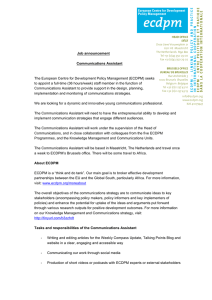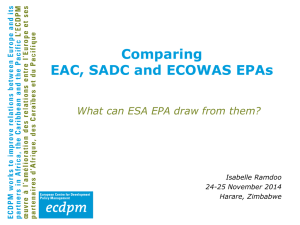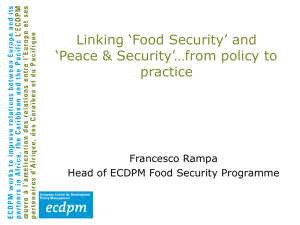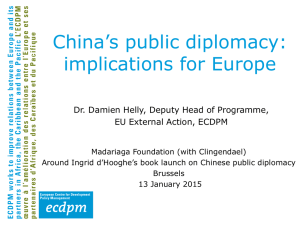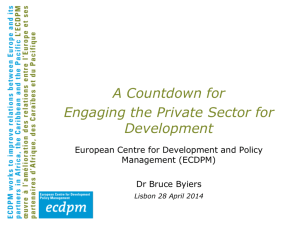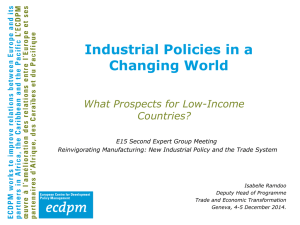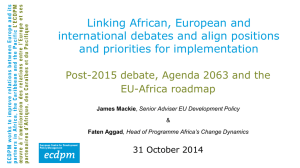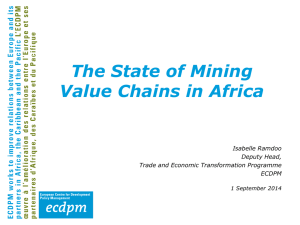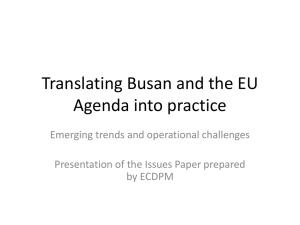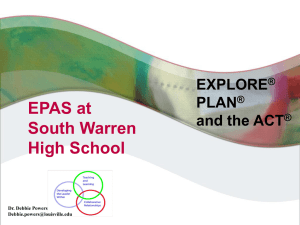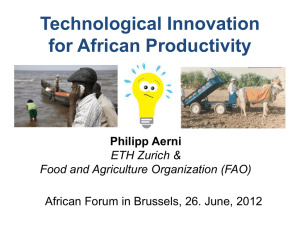publication
advertisement
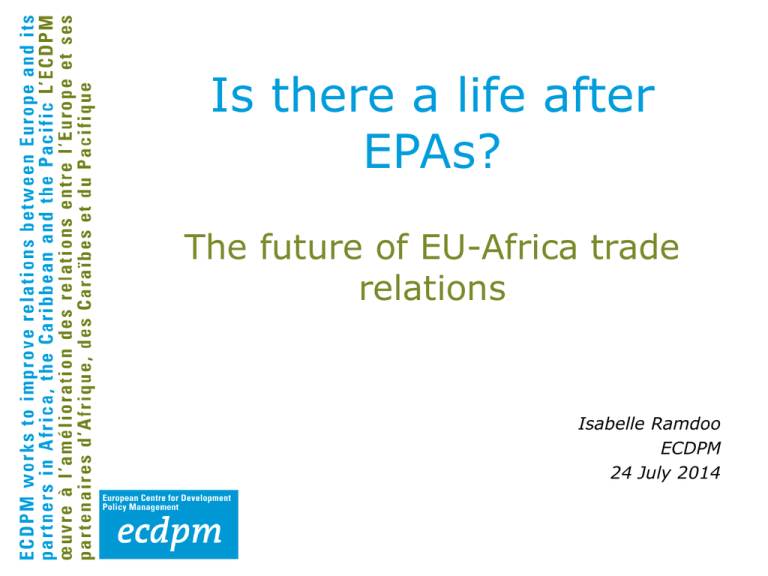
Is there a life after EPAs? The future of EU-Africa trade relations Isabelle Ramdoo ECDPM 24 July 2014 Structure of the presentation Part 1 : State of play of the relationship between EU and African regions/countries • Who’s in? Who’s out? • What’s in? What’s out? • What now? Part II: EU trade relations with third parties: what implications for EU-Africa trade ties? • Mega trade deals Part III: Conclusion: some suggestions ECDPM Page 2 PART I BRIEF OVERVIEW OF EU-AFRICA RELATIONSHIP EPAs: WHO’S IN? WHO’S OUT? WHAT’S IN? WHAT’S OUT? WHAT NOW? ECDPM Page 3 Who’s in? ECDPM Page 4 Who’s out? ECDPM Page 5 What’s in? ECDPM Page 6 What’s in? ECDPM Page 7 What’s out? The current EPAs are about trade in goods. Services, TRIPs and other trade-related issues are not included. Most of them are in a RDV clause but there is no hurry and no specific timeline to conclude on these. Critical issues – domestic support to EU farmers for instance, have not been fully captured. Still left to multilateral negotiations but with slow progress at the WTO, these may not be addressed soon; Still too many trade arrangements governing trade between EU and Africa: EPAs, EBA, GSP, DCFTA with North Africa. No mention on how to address these inconsistencies, that are a serious barrier to building regional markets and value chains (cumulation does not work well among those regimes) Most regions (except for WA) have only an FTA, with no financial package attached to it to address fiscal challenges EPAs could bring, and a limited focus on “development”. Remember EPA was supposed to be about development…. ECDPM Page 8 What implications on the African agenda? • • • • ECDPM The way EPAs are designed currently: will maintain the status quo in terms of trade flows (i.e maintain access to EU for unprocessed goods) Implication for BIAT? Some major concerns as they lock region in their current configuration – how to you address overlapping memberships or enlargement of existing blocks with EPAs? Preferences: Countries still give more preferences to EU (ie DFQF) than to their sister RECS. Are we now prepared to extend such preferences to ourselves? Enter Mega trade deals: Today EU’s FTAs account for less than 40% of its total trade – 60% IS STILL NOT COVERED Page 9 What now? • • • • • • ECDPM Legally: countries that have “initialed” new EPAs or taking steps to sign and ratify existing interim EPAs will preserve MA; others will be added to GSP; Any UMIC might lose GSP after January 2016. Rendez-vous clauses in EPA texts on services, investment and other trade-related issues. But no deadline and therefore no hurry. Sequencing is crucial here In the mean time, EU is negotiating FTAs (and mega-deals) with its main partners: important to closely watch them carefully and take measures at national/regional/continental level to minimise impacts Use as far as possible the EPAs to get access to more favourable treatment (including on non-tariff measures) that EU will grant to other partners (MFN is applicable to EU as well) On the African side: Regional integration agenda, BIAT, CFTA, AIDA, CAADP more important than ever to deepen regional/continental integration and to build solid regional markets and to mitigate potential negative impacts of EPAs Need to address lock-in effect of EPAs Page 10 PART II EU TRADE AGREEMENTS WITH THIRD PARTIES WHAT IMPLICATIONS FOR AFRICA-EU TIES? CASE OF MEGA TRADE DEALS ECDPM Page 11 Why mega-deals? • WTO negotiations are in a deadlock; Key issues about agriculture and industrial products were not addressed in Bali • Big players feel need to reshape global trading system as globalisation deepens and the world become more interconnected. About 60% of global trade is made of of trade in intermediaries. Multilateral system does not respond to some challenges linked to that • Strategic interest. Geopolitical rise of China – soon to be the leader in global trade. A way for EU and US to join forces to maintain access to key markets • In case of EU – More than 60% of its trade is not covered by FTA. ECDPM Page 12 Who are EU’s main trading partners? EU does not have a trade agreement yet in place with countries representing >60% of its trade Source: European Commission, 2014 ECDPM Page 13 EU Mega Trade Deal: The rationale ECDPM Page 14 But mega-trade deals are becoming strategic for all bog players. Three major ones: 1.Trans-pacific partnership (TTP) – 12 countries incl. US, Japan, Canada, Australia, Singapore, Mexico, Chile, New Zealand, Brunei, Peru, Vietnam and Malaysia. 2. Transatlantic Trade and Investment Partnership (TTIP) between EU and US 3. Regional Comprehensive Economic Cooperation (RCEP), 16 countries of which 10 ASEAN countries (Brunei, Myanmar, Cambodia, Indonesia, Laos, Malaysia, Philippines, Singapore, Thailand, Vietnam); Australia, China, India, Japan, S. Korea, New Zealand. ECDPM Page 15 Therefore: new approach to trade diplomacy 1. Trade is not only about tariff, it is about a. Regulation, standards, norms b. Licensing practices c. Domestic taxes d. Investment 2. a. b. c. Trade is not only about trade, it is about Human rights; Environment; Labour rights Need to look at the future trade relationship between Europe and Africa in a broader context – the inter-connectedness between Europe and big players will have spill-over effects on EU-Africa trade relations ECDPM Page 16 Key elements of the TTIP and the TTP • Tariffs (more important for US-Pacific TTP than EU-US TTIP) and potentially subsidies in agriculture • Trade in services, investment (possibly including state-investors dispute), intellectual property • Trade-related issues such as government procurement, competition policy, e-commerce, environment, state-owned enterprises (for TTP) • Regulatory and non-tariff measures such as norms, standards, testing requirements, procedures, technical regulation, food safety ECDPM Page 17 In the case of the TTIP between EU and US • Regulatory barriers will be the heart of the EU-US negotiations • It is estimated that av. Tariff protection on imports in EU and US range between 2.2 – 3.3% respectively, while ad valorem tariff equivalent protection form NTMs range between 19% - 73%. • It is also estimated that up to 50% of those barriers could potentially be eliminated (most optimistic scenario) • If standards are harmonised, this will imply that non-parties to the agreement will be requested to meet those standard to remain competitive on the market • Third countries (incl. African countries) will therefore face higher compliance and trade costs if they want to maintain access to these markets (despite their existing trade regimes with EU – EPA or not!!) ECDPM Page 18 Where does that leave us in Africa? Mega trade deals will NOT be mainly about tariffs. They will basically set new “standards” and “norms” and will involve far-reaching agreements on services and investment with major implications for product quality; Impact will depend on the level of dependency on countries’ trade on EU or US market. Today, 40% of Africa’s trade is destined to EU or US. Higher trade concentration, higher risk of preference erosion or impact of standards-taking ECDPM Page 19 Our RoO are quite flexible – good for us but means that they open the backdoor for cheap inputs (if standards are lowered) that will impact on the cost of production in Europe If change in regulations are anticipated and properly managed to what we want, flexible RoO could lead to this… ECDPM Page 20 Impacts: • According to some estimates, overall impact of EU-US TTIP is expected to be lower than the US-Pacific TTP on African countries because trade structures vary significantly. What we trade with EU and what US trades with EU is quite different. In Asia, different, there is competition from developing countries with our exports to US. • However complementaries are high because Africa is a major supplier of inputs and raw materials to EU and US. • In the short term, sourcing of these products might increase. Positive for exports, foreign exchange earning, jobs etc. • But in the medium to long term it may have a perverse effect: may have a lock-in effect and therefore marginalise African countries from participation in global value chains, affecting industralisation prospects. Hence the need to be active on our own agenda. ECDPM Page 21 Conclusion: some suggestions 1. Critical to follow the current mega-deal negotiations, as they will set the tone for the evolving global trading system 2. African countries should on their side, take unilateral initiatives to calibrate domestic reforms to be prepared to meet standards. Otherwise the risk is marginalisation since you will de facto become rules takers. 3. In parallel, since the Africa group is a strong one at the WTO, ensure that they are at the forefront in negotiations there to ensure big players do not “multilateralise” their FTAs through WTO. There is a real role to play there to ensure advanced countries and few large developing countries do not have the monopoly of setting standards and rules, to impose them on countries that did not have their say in the negotiations ECDPM Page 22 4. In regional/continental trade agenda: Ensure regulatory reforms reflect clearly regional realities and priorities and they have sufficient safeguards to mitigate undesirable impacts of such agreements. Regional trade agreement, BIAT and CFTA discussions could consider strengthening cooperation in NTMs, though possible harmonisation or mutual recognitions, based on regional highest common denominators 5. EPAs have RDV clauses and US might ask for FTA in the future (beyond goods): but ensure proper sequencing this time by completing regional/continental agenda first before opening up on issues where countries and regions are unprepared and have not measured fully the consequences. The risk is that as EU and US conclude advanced FTAs, this will become the standard for their future trade deals and might be difficult to resist, if unprepared. ECDPM Page 23 Thank you for your attention Visit our website: www.ecdpm.org Contact: ir@ecdpm.org Follow me on twitter: @ir_ramdoo The powerpoint can be downloaded on www.slideshare.net/ecdpm Page 24
